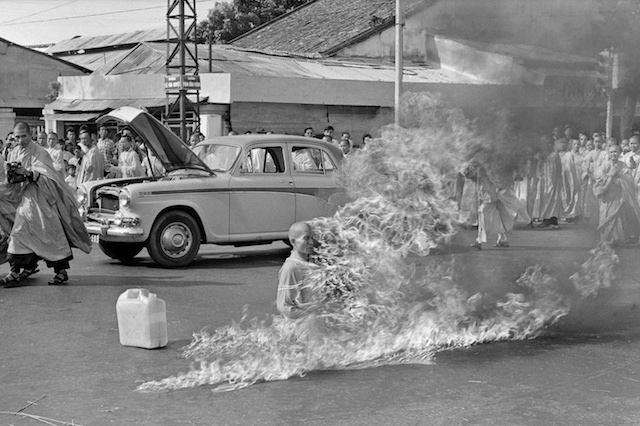A 20-year-old Tibetan student, Tenzin Choeying, self-immolated in July, 2017, in Varanasi, India, after shouting “freedom” and “victory to Tibet.”
He initially survived the fire, leaving 50 percent of his body burned, though he passed away just over a week later.
In a note to his brother, Tenzin Tsundue, Choeying wrote, “Please don’t cry. Tell everyone that my body is for Tibet.”
According to Al Jazeera, the first Tibetan to set himself on fire in 2017 was a young farmer in southwest China, in March. The Tibetan government-in-exile in India said he was the 146th Tibetan to self-immolate since 2009. In many of these cases, the protesters die within one to two days after experiencing severe burns over their entire bodies.
Most of the protesters have been monks and nuns, but there have been many teenagers as well.
When I learned about the practice of self-immolation, and saw pictures and stories in the Tibetan Museum in Dharamsala, India, of young people who chose to burn themselves to death, I was shocked. I began researching this topic to find out more, in the hopes of spreading the news about the reasons behind these protests and helping Tibetans in some way.
Although I don’t believe in self-immolation, I recognize it as a desperate act that sends a strong message. We can only imagine what these people were going through to reach such a drastic state. It’s important for the public to know what has been going on in this part of the world, and to expose the hypocrisy and rigidity of China. China is committing violations against Tibetans by destroying ancient villages and attempting to erase their culture.
When I was in Dharamsala last year, I met Tibetans who shared their stories with me—stories of witnessing the violence done to their parents by Chinese soldiers, being imprisoned and tortured, and fleeing their homes by foot for months over the Himalayas to try and reach safety in India.
One of the men I met is over 70 years old.
I had come out onto the main street in McLeod Ganj, the one leading up to the Dalai Lama’s main temple, where His Holiness was meant to be passing through on his visit to the temple that sunny day. We missed His Holiness, but on that street lined with Tibetan vendors, I instead met this lovely, stocky, dark-eyed, sunburnt man with a beaming smile.
He was wearing traditional, colourful clothing and a handmade cloth hat. He was smiling through tears because he had just seen his hero and spiritual leader pass by, and received his blessings. He was overjoyed.
At the same time, many traumatic memories had been triggered by this event. He needed to alleviate his suffering, so he told us his story. When he was five years old, he had witnessed the Chinese army knock his father unconscious by hitting him with a shotgun, tie him up, and drag him away, never to be seen again. They were nomad yak farmers, so he and his mother, brother, sister, and animals were all packed up shortly after that incident. Fearful of the return of the soldiers, they escaped by foot in the dead of winter, over the narrow, treacherous pathways set on the edge of the Himalayan mountains, all the way to Dharamsala, India. His parents had agreed to leave Tibet if anything ever happened to either of them, or if things got worse under Chinese occupation.
Yet another man, Venerable Bagdro, who is a friend of the old man I met, invited my travel companions and me into his small room, which included a single bed, some books, a radio, silver pots, dishes, a picture of the Dalai Lama, some white silk offering scarves, a Tibetan mala, a singing bowl, and not much else.
Venerable Bagrdo had been imprisoned by the Chinese and tortured for two decades, until he was finally released and placed in exile. Upon his release, he spoke with the His Holiness and, in a fit of rage and hurt, said he wanted to leave monastic life, get revenge, and fight against the Chinese. His Holiness advised him instead to remain a monk and use his words and story to combat the Chinese. He encouraged him to write his story and share it with the world to raise awareness of the plight of Tibetans.
Ven. Bagdro has since written many books and spread his story to many countries. When I met him, he gave me a copy of his book and asked that I share his story and the atrocities Tibetans are facing, such as the disappearance of Panchen Lama, the next Dalai Lama, the exile of His Holiness and Tibetans from their country, and the violence and religious and cultural oppression they have faced, with as many people as I can.
These are the kinds of stories so many Tibetans, young and old, monks and lay people, are motivated by in these drastic and desperate acts of self-immolation.
Rather than listening and changing course, the Chinese seem determined to destroy.
In January 2013, Didi Tang, of the Associated Press, reported on the public prosecution of Tibetans who protest policies to reject the Dalai Lama and destroy ancient culture. Eight Tibetans were convicted of jeopardizing public safety and accused of coercing others to self-immolate. These trials showed that Beijing was getting more serious in trying to slow the protests and weaken sympathy for protestors by declaring self-immolation criminal.
Beijing wanted the public to believe there were ulterior motives for the protests—to further the Dalai Lama’s goal to split Tibet from China—and with the sentencing of these cases, they wanted the international community to see the methods of protest being used as evil and malicious.
Since 2009, it is confirmed that almost 146 Tibetan monastics and lay people, some teenagers, have set themselves on fire. Their main intentions: to plea for religious freedom, the ability to express Tibet’s national identity, and the return of the Dalai Lama from exile.
China says it “liberated” Tibet in 1951 with the help of its troops, but many Tibetans still talk about experiencing religious oppression and erosion of their culture by the Chinese government.
China claims that “Tibet has never been an independent nation,” and that “Tibet has been transformed from a poor and backward society to one that is advanced.”
Tibetans disagree, and have appealed to the United Kingdom, warning that failing to stand up to China only supports its efforts to impose an antidemocratic plot on the world.
The Dalai Lama does not encourage or support protests, but he has praised the courage of those who stand up to China’s “cultural genocide” in Tibet. He has also proposed a “Middle Way Approach” with China to set realistic expectations for the future of Tibetans.
The Dalai Lama also said he thinks of self-immolation as an act of non-violence because nobody else is harmed, unlike in a suicide bombing. He questioned the effectiveness of such actions, though, and said that they lead to increased repression.
Cultural genocide involves the obliteration and destruction of artefacts including books, art, structures, and the suppression of activities that the destroyer deems inappropriate. This may happen because of religious motives, or as part of an ethnic cleansing campaign to remove evidence of groups of people from history.
What has happened to the Tibetan people at the hands of the Chinese can only be defined in this way.
It is important to raise awareness of this situation because the history and culture of Tibet play a substantial role in Buddhist history. Acts of cultural genocide have happened in many parts of the world, and, having been born in Apartheid South Africa and exposed to this first hand, they touch me deeply.
In a 2014 interview with Tibetologist Thierry Dodin, he discusses the severity of and potential reasons for these fiery protests:
“First of all, let us establish that before putting an end to your life in such a terrible way, you must have gone through a lot of suffering, and also considered other, less drastic options, before finally settling for burning yourself. This is not something you do simply in a sudden impulse. Behind each and every case of a Tibetan burning him or herself is a very personal human drama and this drama does not begin with the act of self-immolation itself. In fact, it is the act of self-immolation itself that stands at the end of a long drama. Through this act, the individual who burns himself intends to put an end to this drama.
So let’s stick to the facts: In Tibet, where China pretends to have liberated the population from obscurantism and imperialism and led it to a better life, there are dozens of Tibetans who burn themselves to express their political frustration. Full stop. I think that speaks for itself. The regime got the message very clearly. And they are so afraid that we get it too, and they are so helpless about it that their only recourse is defamation and extinguishers.“
The Chinese government wants to shirk their responsibility in these deaths by pointing fingers, rather than being truthful and accepting the Dalai Lama’s “Middle Way Approach.”
We need to be aware of these acts in order to help prevent them.
Since my experience of meeting these amazing Tibetans in India, I have asked myself many times, “How could I help? How could I be of benefit?”
I know one way to help is to share their stories. They have such a rich cultural and religious heritage that should not be suppressed. Just like us, they deserve to be free in every way possible.
My heart goes out to these kind and gentle people.
Ven. Bagdro, the Tibetan monk I met in Dharamsala and author of A Hell on Earth—A Brief Biography of a Tibetan Political Prisoner, calls on the international community, including journalists, businesses, and governments, to exert greater pressure on the Chinese government to stop the large-scale human rights violations in Tibet. “The West is only interested in business deals with China. They do not bring this issue to the fore. Chinese leaders are wearing a mask…to which everyone turns a blind eye.”
Let’s not turn a blind eye to the plight of these people. Let’s help them by sharing these events with others, in the hopes of preventing further pain and loss.
~
Author: Rose Mina Munjee
Image: Wikipedia
Editor: Emily Bartran
Copy Editor: Travis May
Social Editor: Danielle Beutell







Read 0 comments and reply